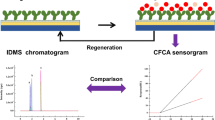Summary
The quantitation of myoglobin (Mb) in serum and urine is of clinical importance for the differentiation of myocardial infarction from degenerative cardiac disorders as well as for the detection of traumatic and atraumatic rhabdomyolysis, followed frequently by acute kidney failure.
A simple method is described to prepare myoglobin from human muscle extract by negative pressure ultrafiltration and dialysis. By a combination of electrophoretic procedures, this preparation was analysed for purity.
Saline myoglobin solutions after deep freezing loose rapidly their immunoreactive Mb content. By addition of pure albumin, not containing heme binding proteins, a stable Mb solution was obtained. This has been used as standard (5–50µg/ml) in radial immunodiffusion sensitive for detecting 0.2–1 µg Mb/ml.
Similar content being viewed by others
References
Antonini, E., Brunori, M.: Hemoglobin and Myoglobin in their reactions with ligands. Vol. 21 of ‘Frontiers of Biology’, ed. by A. Neuberger, E. Tatum. London: North Holland 1971
Boesken, W. H., Kopf, K., Schollmeyer, P.: Differentiation of proteinuric diseases. Clin. Nephrology1, 311–318 (1973)
Grossman, R. A., Hamilton, R. W., Morse, B. M., Penn, A. S., Goldberg, M.: Nontraumatic rhabdomyolysis and acute renal failure. New Engl. J. Med.291, 807–811 (1974)
Kagen, L. J.: Immunologic detection of myoglobinuria after cardiac surgery. Ann. Int. Med.67, 1183–1189 (1967)
Keller, P., Münscher, G., Pfeffer, G.: Immunologischer Myoglobinnachweis beim Herzinfarkt. Therapiewoche11, 1784 (1976)
Kossmann, R. J., Camp, W. A., Engle, R. L.: Idiopathic recurrent myoglobinuria. Am. J. Med.34, 554–564 (1963)
Levine, R. S., Auterman, M., Gubner, R. S., Adams, E. C.: Myoglobinuria in myocardial infarction. Am. J. Med. Sci.262, 179–183 (1971)
Luginbuhl, W. H.: A method of crystallisation of human myoglobin. Proc. Exp. Biol. Med.105, 504–505 (1960)
Maurer, H. R.: Discelectrophoresis. Berlin: DeGruyter 1971
Olerud, J. E., Clark, D. L.: Factors affecting assay of myoglobin by complement fixation or immunodiffusion. Clin. Chem.21, 1654–1657 (1975)
Perkoff, G. T., Hill, R. L., Brown, D. M., Tyler, F. H.: The characterization of adult human myoglobin. J. Biol. Chem.237, 2820–2827 (1962)
Rowland, L. P., Dunne, P. B., Penn, A. S., Maher, E.: Myoglobin and muscular dystrophy. Arch. Neurol.18, 141–150 (1968)
Saranchak, H. S., Bernstein, S. H.: A new diagnostic test for acute myocardial infarction. JAMA228, 1251–1255 (1974)
Volk, P., Fittschen, U., Begemann, M.: Myoglobin in Serum nach Herzinfarkt. Münch. Med. Wschr.115, 2122–2128 (1973)
Wu, C. C., Duffy, P., Brown, W. D.: Interaction of myoglobin and cytochrome C. J. Biol. Chem.247, 1899–1903 (1972)
Author information
Authors and Affiliations
Additional information
Supported in part by a grant Bo 378/7 of the Deutsche Forschungsgemeinschaft
Rights and permissions
About this article
Cite this article
Boesken, W.H., Boesken, S. & Mamier, A. Human myoglobin: Preparation, quantitation and standardization. Res. Exp. Med. 171, 71–78 (1977). https://doi.org/10.1007/BF01851590
Received:
Issue Date:
DOI: https://doi.org/10.1007/BF01851590




